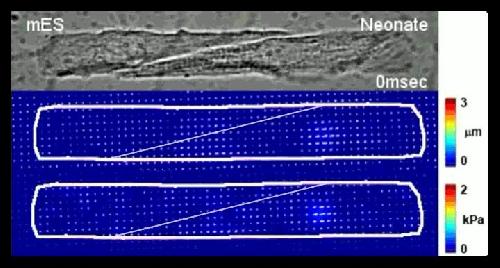Boston - With every heart attack, billions of cardiomyocytes, the contracting heart muscle cells that make the heart pump time after time over a lifetime, are lost which can lead to heart failure or injury. Stem cell-based replacement strategies could open new and much needed therapeutic avenues. Such approaches, using either patient-derived or donor-derived stem cells, have been taken in clinical trials but thus far have not fulfilled their early promises. To eventually be able to design more appropriate treatments, many cardiologists and regenerative biologists have come to think that novel assays are needed to better understand the basic science behind stem cell therapy.
A new study published in the February 15 issue of the Journal of Cell Biology by Kit Parker's research team at the Wyss Institute for Biologically Inspired Engineering and the John A. Paulson School of Engineering and Applied Sciences (SEAS) at Harvard University suggests that stem cell-derived cardiomyocytes have weaker contractile strength than their biological counterparts isolated from heart tissue. The findings could help explain critical shortcomings of stem cell-derived heart muscle cells in clinical trials.
"Our study suggests the utility of basic, in vitro cell biology studies in explaining clinical observations and pointing to potential pitfalls of cell therapies. These kinds of studies, coupled with appropriate clinical approaches, may offer a unique strategy to vet new therapeutic opportunities," said Parker, Ph.D., who is a Core Faculty member of the Wyss Institute and the Tarr Family Professor of Bioengineering and Applied Physics at SEAS.
 This video shows how a pair of embryonic stem cell-derived cardiomyocyte (left cell) and neonate primary cardiomyocyte (right cell) synchronously contracts (top) as a two-cell microtissue. As indicated by the level of red color in the heat maps, the primary cardiomyocyte shortens its length more than the stem cell-derived cardiomyocyte (middle) and develops greater contractile forces (bottom) during the contraction. Credit: Credit: Wyss Institute at Harvard University.
This video shows how a pair of embryonic stem cell-derived cardiomyocyte (left cell) and neonate primary cardiomyocyte (right cell) synchronously contracts (top) as a two-cell microtissue. As indicated by the level of red color in the heat maps, the primary cardiomyocyte shortens its length more than the stem cell-derived cardiomyocyte (middle) and develops greater contractile forces (bottom) during the contraction. Credit: Credit: Wyss Institute at Harvard University.
To study stem cell-derived cardiomyocytes and compare their chemical and mechanical properties to those of cardiomyocytes in actual heart tissue, Parker's team made use of a previously engineered heart muscle on-a-chip platform that supports the growth and maturation of cardiomyocytes in two-cell microtissue constructs. Pairing up stem cell-derived cardiomyocytes with each other (homogenous pairs) or with primary cardiomyocytes (heterogenous pairs) revealed surprising differences.
"We found that different types of stem cell-derived cardiomyocytes form the expected cell-cell junctions between each other and with primary cardiomyocytes. Through these junctions, cardiomyocytes aligned their contractile machineries and contracted synchronously. However, when we investigated the contractile strengths of homogeneous and heterogeneous pairs with traction force microscopy, we found stem cell-derived cardiomyocytes to be significantly weaker," said Francesco Pasqualini, Ph.D., who together with Yvonne Aratyn-Schaus, Ph.D., is a co-first author of the study.
Both performed their work as Postdoctoral Fellows in Parker's team and Pasqualini was recently appointed a Senior Scientist at the newly founded Wyss Translational Center Zurich to continue his work in heart regenerative research. Interestingly, the team also noticed increased numbers of compensatory substrate adhesions between stronger and weaker cardiomyocytes in heterogenous pairs whose role it is to keep the pair from rupturing, but which might also transmit mechanotransductive signals.
"So far, these differences in contractility and adhesion have not been considered before the initiation of pre-clinical and clinical studies," said Pasqualini. "And yet an equilibrated contractile strength may be necessary for cardiac cell therapy to work, independently from the exact type of transplanted cell."
In addition, the team built a computational model that can simulate the force imbalances present in heterogenous cell pairs of both murine and human stem cell-derived cardiomyocytes.
"This work is a nice example of the power of the beating heart-on-a-chip technology to gain greater insight into the biological mechanisms that underlie stem cell function in a tissue and organ context. It also could be used to select for more highly functional stem cell-derived cardiomyocytes, or identify pharmacological or genetic interventions that can facilitate their use in regenerative medicine," said Wyss Institute Founding Director Donald Ingber, M.D., Ph.D., who is also the Judah Folkman Professor of Vascular Biology at Harvard Medical School and the Vascular Biology Program at Boston Children's Hospital and Professor of Bioengineering at the Harvard John A. Paulson School of Engineering and Applied Sciences.
source: Wyss Institute for Biologically Inspired Engineering at Harvard